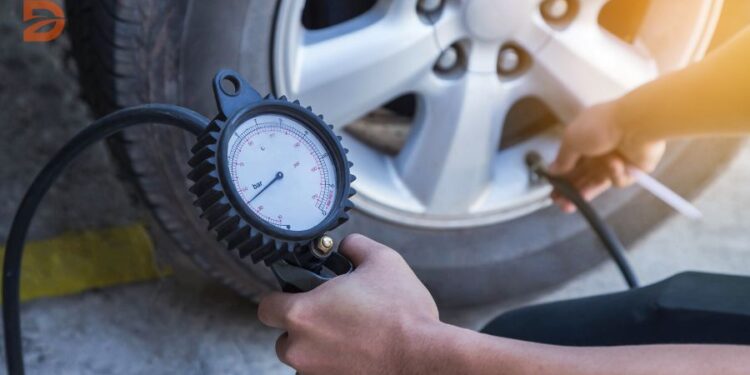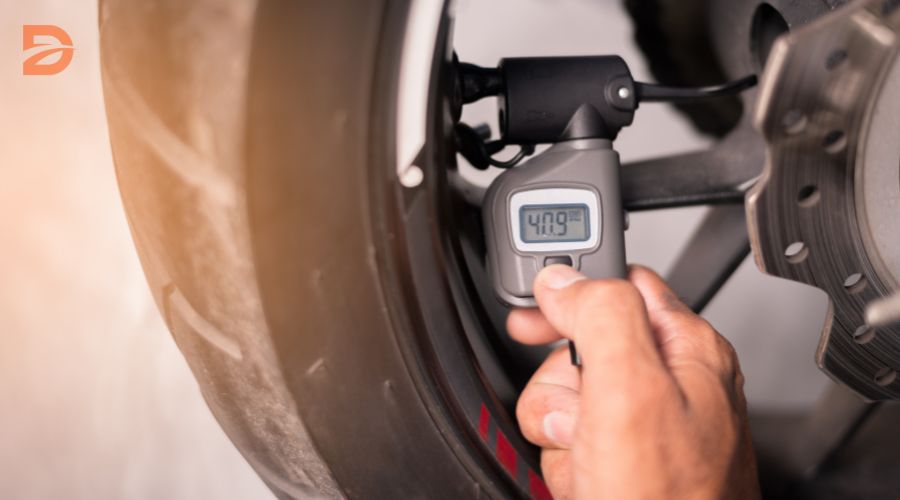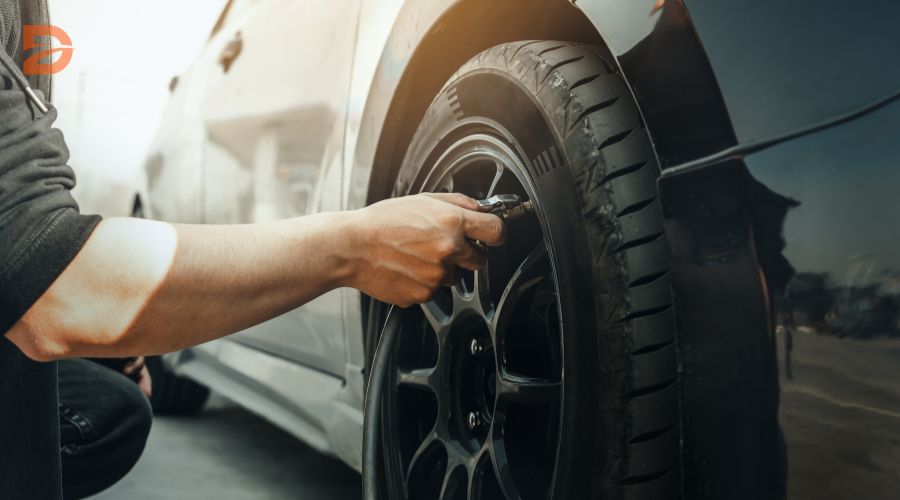Did you know that the Transportation Recall Enhancement, Accountability, and Documentation (TREAD) Act mandated the inclusion of Tire Pressure Monitoring Systems (TPMS) in all vehicles under 10,000 pounds Gross Vehicle Weight Rating (GVWR) sold in the United States since 2008? This groundbreaking legislation recognized the critical importance of maintaining proper tire pressure for vehicle safety and efficiency.
Proper tire pressure is essential for safe driving, as it directly affects a vehicle’s handling, stopping capabilities, and fuel efficiency. Underinflated or overinflated tires can pose serious risks, including the potential for a catastrophic tire blowout that could lead to a severe crash. The Tire Pressure Monitoring System was developed to address this issue, providing drivers with a vital tool to monitor and maintain optimal tire pressure for their vehicles.
Key Takeaways:
- TPMS systems help prevent accidents and enhance overall road safety by alerting drivers to low tire pressure
- Properly maintained tire pressure can improve fuel efficiency by 3-4%
- Direct TPMS sensors typically last 5-10 years before needing replacement due to battery depletion
- Regular visual inspections and timely response to TPMS warnings are crucial for tire health and vehicle safety
- TPMS relearning procedures can be done manually, through OBDII tools, or using specialized TPMS trigger tools
Understanding the Importance of TPMS
Tire Pressure and Vehicle Safety
Proper tire pressure is essential for overall tire performance and vehicle safety. Underinflated or overinflated tires can significantly impact vehicle dynamics, handling, and stopping capabilities, as well as fuel efficiency. Incorrect tire pressure increases the risk of tire failure, such as blowouts, which can lead to severe crashes.
According to the National Highway Traffic Safety Administration (NHTSA), underinflated tires are three times more likely to cause a serious accident than properly inflated tires. The U.S. Department of Energy reports that properly inflated tires can improve fuel efficiency by up to 3%, saving an average of 11 cents per gallon. The NHTSA also estimates that underinflated tires can cause a vehicle to consume up to 6% more fuel and reduce tire life by 25%.
Tire Pressure Monitoring Systems (TPMS) are designed to monitor the air pressure in each tire and provide real-time information to the driver, helping to maintain optimal tire pressure and enhance vehicle safety. TPMS can extend tire life by helping drivers maintain proper tire pressure, reducing the risk of uneven wear. The system also offers up to 3% improvement in fuel efficiency by maintaining optimal tire pressure.
“TPMS is crucial for vehicular safety and efficiency, with benefits applicable across vehicles of varying vintages and types.”
| Metric | Impact |
|---|---|
| Underinflated Tires | 3x more likely to cause a serious accident |
| Proper Tire Inflation | Up to 3% improvement in fuel efficiency |
| Underinflated Tires | Up to 6% more fuel consumption |
| Underinflated Tires | 25% reduction in tire life |
| TPMS | Up to 3% improvement in fuel efficiency |
The Evolution of Tire Pressure Monitoring Systems
The concept of a “low tire pressure warning” light was first considered in the 1970s, but the technology was too expensive at the time. The journey of tire pressure monitoring systems (TPMS) has been a steadfast progression, driven by the automotive industry’s commitment to improving vehicle safety and efficiency.
The first TPMS system appeared on the Chevrolet Corvette in 1989, marking an important milestone in the technology’s history. Over the years, TPMS has become a standard or optional feature in many vehicles, reflecting its growing importance in the automotive landscape.
In 2000, the Tire Recall Enhancement, Accountability, and Documentation (TREAD) Act was a crucial turning point. This legislation mandated the installation of TPMS in all new vehicles under 10,000 pounds GVWR, starting in 2008. This regulatory push was instrumental in driving the widespread adoption of TPMS, underscoring its role in enhancing vehicle safety and preventing accidents caused by underinflated tires.
The evolution of tire pressure monitoring systems has been further shaped by advancements in automotive technology and safety regulations. From the early days of the Corvette’s implementation to the TREAD Act’s mandate, TPMS has become an integral part of the modern vehicle, providing real-time monitoring and helping drivers maintain optimal tire pressure for safe and efficient driving.
| Region | TPMS Adoption |
|---|---|
| Sweden, Germany, and Spain | 54% of passenger cars were found without TPMS in a 2016-2017 survey |
| United States | TPMS introduced in 1991 for the Corvette |
| European Union | TPMS became mandatory for all new cars sold from November 1, 2014 |
| South Korea | TPMS requirement for passenger vehicles and vehicles of GVW 3.5 tons or less, effective January 1, 2013 |
As the TPMS technology continues to evolve, it has become increasingly integrated with vehicle electronics, enabling smart monitoring, predictive maintenance, and enhanced driving safety. The future of tire pressure monitoring systems promises even greater advancements, further solidifying their role in the ever-advancing automotive landscape.
Tire pressure monitoring, TPMS: How Does It Work?
Tire Pressure Monitoring Systems (TPMS) play a crucial role in ensuring the safety and performance of your vehicle. These systems employ two main technologies: direct TPMS and indirect TPMS. Direct TPMS utilizes sensors installed within each tire that continuously monitor air pressure and communicate the data to the vehicle’s onboard computer. This allows for accurate readings and immediate alerts if the pressure drops below a safe threshold, typically around 32 to 35 psi when the tires are cold.
On the other hand, indirect TPMS relies on the vehicle’s Antilock Braking System (ABS) sensors to approximate tire pressure by comparing the revolution rate between wheels. While indirect TPMS may not provide the same level of precision as direct TPMS, it still serves the purpose of alerting drivers when a tire is significantly underinflated. Both systems work together to keep you informed about the state of your tires, helping to maintain optimal performance and reduce the risks associated with improper tire inflation.
Modern TPMS systems employ wireless technology, such as radio frequency (RF) signals, to transmit the collected data to the vehicle’s computer. This allows for real-time monitoring and alerts, ensuring that you receive timely warnings about any issues with your tires. In some cases, like the TST TPMS system, the integration with telemetry providers can further enhance the reporting capabilities, providing you with a comprehensive view of your vehicle’s tire health and performance.
FAQ
What is the purpose of a Tire Pressure Monitoring System (TPMS)?
The main purpose of a TPMS is to monitor the air pressure in each tire and provide real-time information to the driver. This helps maintain optimal tire pressure, which is crucial for safe driving, vehicle handling, stopping capabilities, and fuel efficiency.
How does TPMS help improve vehicle safety?
Incorrect tire pressure, whether underinflated or overinflated, can adversely affect vehicle dynamics, handling, and stopping capabilities. TPMS alerts the driver when a tire is significantly underinflated, reducing the risk of tire failure and potential crashes caused by loss of vehicle control.
When did TPMS become a mandatory feature in vehicles?
In 2008, the Tire Recall Enhancement, Accountability, and Documentation (TREAD) Act made TPMS a mandatory feature in all new vehicles under 10,000 pounds Gross Vehicle Weight Rating (GVWR) in the United States.
What are the different types of TPMS systems?
There are two main types of TPMS: direct and indirect. Direct TPMS uses sensors within each tire to measure the air pressure, while indirect TPMS uses the vehicle’s Antilock Braking System (ABS) sensors to approximate tire pressure. Both systems serve the same purpose of monitoring tire pressure and alerting the driver when a tire is significantly underinflated.










